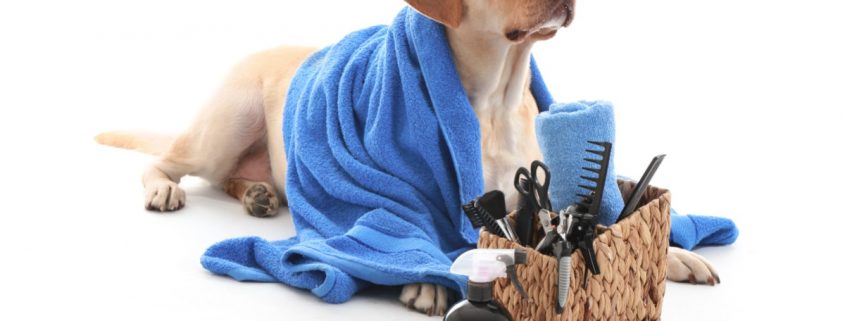Routine, at-home grooming sessions will help your dog look and feel its best. In addition, it allows you to examine your dog’s coat, teeth, eyes, ears, and nails for signs of problems. While good hygiene habits are essential for a healthy dog, most dogs do not require daily hygiene and grooming. What is required, and how often, is breed dependent. Read on for at-home care tips that will keep your dog looking sharp and feeling great between visits to the groomer!
Brushing at Home
Nearly every dog needs occasional brushing. Yes, even your short-haired dog! A good brushing session can remove loose hair and help distribute your dog’s natural oils throughout their coat for a healthy shine. The type of brush or comb you’ll need depends on your dog’s coat texture and length, so be sure to do your research before purchasing grooming tools.
When brushing, always check for burrs, sticks, and other foreign material. Also be on the lookout for mats, which most frequently form behind the ears, where the collar is worn, and under the legs. If you commit to a few short brushing sessions each week you’ll be able to keep your pup looking neat and clean.
Bathing at Home
Most dogs don’t need frequent baths. Unless your dog rolls in the mud or has a messy bathroom moment, once-a-month bathing will usually suffice. Over-bathing can lead to dry, flaky and itchy skin. When you do give baths, be sure to use a conditioning shampoo formulated for dogs. Humans have a different skin and hair pH than dogs, so human shampoo is too harsh. A hypoallergenic shampoo or an oatmeal shampoo are great, gentle options.
When starting up bath time it’s recommended you use lukewarm water. Dogs don’t enjoy hot baths the way people do; in fact, they can quickly overheat if the water is too warm. Once the water is at a good temperature and you start wetting your dog, always start at their back end and work your way forward toward their head. Be careful not to let water get inside your dog’s ears.
As you soap them up, do the same thing and start at their back end and work your way towards their face. Take extra care when soaping up your dog’s head and face to avoid getting shampoo in their eyes. Then rinse, rinse, and rinse again! When you think you have all the shampoo out, rinse for an additional couple of minutes. It’s too easy to accidentally leave a little shampoo in your dog’s coat, which could cause itchy dandruff, skin irritation, or hot spots. Once their coat is thoroughly rinsed out, let your pup shake off that extra water before you towel dry or blow dry their coat. Many wet dogs get the zoomies when they get out of the tub, and yours may run around trying to dry off using the carpet, furniture or any absorbent surface available!
Nail Trimming
Nail trimming is one part of grooming that every dog needs no matter their breed. When neglected, long nails can cause discomfort, difficulty walking, and in some extreme cases can curve into a dog’s paw pad. To prevent such situations, you should plan on trimming your dog’s nails in small increments every two weeks. When doing nail trims, it’s important to avoid trimming too short. Doing so can expose the vein that dogs have in their nails called the “quick,” which will bleed if cut too short.
In dogs with white nails, you are able to see the quick inside the nail and know where to cut. For dogs with black nails, this can be more difficult since you will not be able to see the quick. When trimming dark-colored nails, start out slowly by cutting off a little bit at a time. Once you get close to the quick, you will see a tiny black dot surrounded by a white ring. That’s how you know to stop. In the event that you accidentally cut too short, you can apply styptic powder to stop the bleeding or in a pinch, you can use flour or cornstarch.
Cleaning Ears and Teeth
You should clean out your dog’s ears every time they get a bath. You can use an ear cleaner made for dogs on a cotton ball to gently wipe out any dirt. It’s natural to see a little bit of dirt on the cotton ball after swiping the inside of your dog’s ear, but if the cotton ball comes out gunky or stinky, it may be time for a trip to the vet.
As for your dog’s teeth, they should be cleaned weekly with a toothbrush and special toothpaste designed for dogs. Brushing weekly will help reduce tartar buildup and help with bad breath. If your dog doesn’t like having its teeth brushed, start out slowly by putting toothpaste on your finger and then gently rub their teeth and gums. The more you practice, the more comfortable your pup will become with teeth brushing.
Your Pets are our Priority!
At the National Animal Supplement Council (NASC), our number one priority is to promote the health and wellbeing of your pets. That is why we created the NASC Audit Program and the Quality Seal, which helps you identify animal health and nutritional supplements that come from responsible suppliers committed to producing the highest quality, most consistent products available. Visit our website to learn more and to see a list of NASC members that have earned the Quality Seal.


